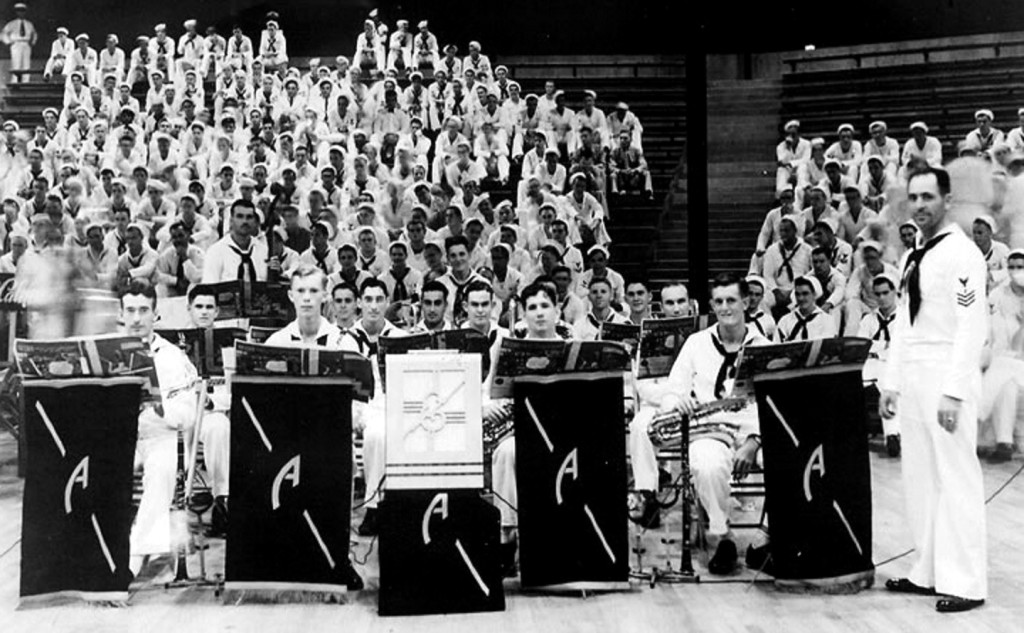When the Japanese attacked Pearl Harbor 82 years ago, December 7, 1941 became “a date that will live in infamy,” as President Franklin D. Roosevelt told the U.S. Congress and the country the following day. With so many tragic stories that stemmed from that horrendous attack, the saga of Navy Band 22 was almost completely lost until publicity generated by the publication of a book in 1996: USS Arizona’s Last Band, by Molly Kent, sister of one of the band members, brought the story to light.
Navy Band 22 is the only band in the history of the U.S. Navy that was formed, trained, transferred to a ship, competed against other bands, fought in combat and died together. Quoting from and adapting a 2016 article from the Milwaukee Journal Sentinel, here is their story.
Fred Kinney served as bandmaster to 20 fellow musicians who came together in May of 1941 to form the band. All the musicians had excelled in music in high school, winning state competitions, many playing in other bands and orchestras in addition to their school ensembles. All played several instruments. Two had formed their own professional dance bands; several had attended college, majoring in music.
Extensive Training
Each had to go through basic training at Naval Station Great Lakes in Chicago, and pass a rigorous audition because only accomplished musicians were accepted into the Navy School of Music in Washington, D.C. At the school, the new recruits enrolled in classes in harmony, musical theory, and ear training, and had instructors for private lessons on both their major and minor instruments. As apprentice seamen, they were paid $21 per month. Musicians in fleet bands stationed on ships had to be versatile—playing military music in the morning, jazz at noon, and symphonic numbers at night. On board, they were responsible for all music played on their vessels—performing for their shipmates during lunch and dinner—as well as additional performances on shore. They ate and bunked together in a compartment on the second deck and spent their non-performance time rehearsing and arranging much of their own music.
After graduation from the Navy School of Music on May 23, 1941, they shipped out and boarded the Arizona while it was docked in Long Beach, California on June 17. Replacing a band of older musicians, they played a concert shortly after boarding their new home and got an enthusiastic response from the younger sailors who appreciated the new group being able to play hits from the popular swing bands of the day and modern dance music.
The Battle of Music
By the fall of 1941, swarms of new sailors had descended on Hawaii as the U.S. ramped up its military presence in the Pacific. Most were teenagers with no money, which meant they spent much of their free time on their ships. To keep the men entertained, the military organized sporting and music contests. Among the competitions was the Battle of Music featuring 17 Navy bands and one Marine Corps barracks band. Every other Saturday night, four bands competed, with the winner chosen by audience applause.
Arizona’s band qualified for the finals on November 22. Two weeks later, many of the band members attended another qualifying competition on the night of December 6. They were eager to see the USS Tennessee’s band perform because they had graduated from music school together. The Tennessee band joined the Arizona among the four finalists, scheduled to compete on December 20.
Fateful Morning
The morning of December 7, two rows of uniformed band members stood on the USS Arizona’s fantail warming up, waiting to play the National Anthem at 8 o’clock sharp. They didn’t get to play a single note of the “Star-Spangled Banner” as Japanese dive bombers began swooping down out of the sky a few minutes before the colors could be posted.
The band members could see the planes with the Rising Sun on their wings shooting at them and knew it wasn’t a rumor anymore that Japan would attack America. All 21 band members dropped their instruments and ran to their battle stations below decks. They had been trained as ammunition handlers in the event of an emergency. When the Arizona blew up a few minutes later, 1,177 men on board the battleship lost their lives. Among the casualties was the entire U.S. Navy Band 22.

With the United States at war, and Pearl Harbor digging out from the attack, the Battle of Music final was canceled. Instead, band members from the other ships voted unanimously to award first place to the USS Arizona’s band. Several musicians said the Arizona was the best band without question. The trophy was permanently renamed the USS Arizona Band Trophy and is inscribed with the 21 musicians’ names. It now sits in the Arizona Memorial Museum at the state capitol in Phoenix.
Lew Shaw started writing about music as the publicist for the famous Berkshire Music Barn in the 1960s. He joined the West Coast Rag in 1989 and has been a guiding light to this paper through the two name changes since then as we grew to become The Syncopated Times. 47 of his profiles of today's top musicians are collected in Jazz Beat: Notes on Classic Jazz.Volume two, Jazz Beat Encore: More Notes on Classic Jazz contains 43 more! Lew taps his extensive network of connections and friends throughout the traditional jazz world to bring us his Jazz Jottings column every month.





















